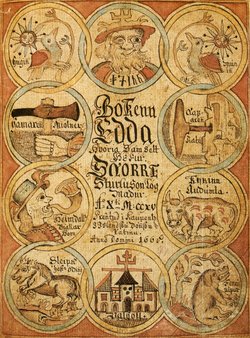|
Icelandic epicIcelandic literatureIcelandic epic literature was written down some two centuries after the island was settled in the 9th century. Icelandic epic can be divided into three categories: 1. Eddic poetry, i.e mythological and heroic poems; 
The Icelandic SagasThe Icelandic Saga is without doubt Iceland's most important contribution to world literature. They are medieval prose narrative, abounding in paradox and irony. Violence is pervasive, but the style is subdued. Heroism is praised, but moderation is more highly prized. Much is said of fate, but the complex characters seem to control their own destinies. The world of the Saga is pagan, but its ethos is humanitarian. Among the more historical Saga literature, based on both oral and written sources, the best known are Ari Thorgilsson's Islendingabok ( Icelandic history ), Snorri Sturluson's Heimskringla ('The Disc of the World', a history of Swedish and Norwegian kings), and the anonymous Knytlinga Saga (a history of Danish kings). An excellent example of the fictional Saga is Hrafnkels Saga, a short bildungsroman. The family Sagas, such as Egils Saga (the story of Iceland's greatest skald, Egill Skallagrímsson) and Njals Saga, fall somewhere between the fictional and factual varieties of sagas. Heimskringla ( Icelandic epic ) is the most celebrated of the Icelandic sagas, but the dramatic Egil's Saga (circa 1220) comes closer. The more ornate Laxdæla Saga (circa 1250) elaborates tragic themes from the poems of the Icelandic epic Edda. In Grettis Saga (circa 1300), which shares motifs with the Old English poem Beowulf, the hero succumbs to pagan sorcery. Njáls Saga (circa 1230-90) both glorifies and repudiates the Saga Age (870-1050), and provides an important description of the ancient Icelandic legal system. The most important of the legendary sagas is Völsunga Saga (circa1250); it was a major source for Wagner's operas, and Retell's parts of the Edda. The Icelandic epic poems Edda and the Prose EddaThe Eddas are two collections of Old Icelandic writings, and together they form the most important source of Scandinavian mythology. The Poetic Edda is a collection of 34 Icelandic poems, interspersed with prose, dating from the 9th to the 12th century. The poems were composed by anonymous poets and deal mostly with mythological themes. Among the most important of these are the poems Völuspá (The vision of the Seeress) and Hávamál (The Speech of the High One). To give some taste of the nature of this poetry, here is a famous quote from Hávamál, where Odin ('The High One') speaks of how he acquired the art of casting runes by being sacrificed on a branch of the World Tree: I know I hung I was struck with a spear They helped me neither I took up the runes, The Icelandic epic Prose Edda is the younger one (circa 1220) is the work of the Snorri Sturluson. It was probably intended as a handbook for novice poets who wished to become skalds, or court poets, in a time when the old pagan tradition was already beginning to fade from men's minds but was still appreciated. Snorri was a brilliant stylist, writing in his native Icelandic; his Edda is no dry antiquarian treatise, but a witty, imaginative and lively account of the old tales of the gods. Despite his being a Christian, there is little doubt that Snorri has given us a faithful picture of Heathen Icelandic mythology as it was known in his day; there are few attempts at rationalizing or pointing towards some Christian moral teaching. It is difficult to know to how far removed Snorri's stories are from the living faith of the pagan era, but despite its limitations, the Prose Edda is the best introduction to the world of Scandinavian mythology in existence.. Later Icelandic epic literatureThe Icelandic epic tradition climaxed in the 13th century. Pre-Reformation literature also includes Eysteinn Ásgrimsson's religious poem Lilja (14th century), a number of popular ballads, and the rímur, which were cycles of Icelandic epic poetry.After the Reformation, Iceland experienced three centuries of poverty, which also affected its literature, although in the 17th century Hallgrímur Pétursson wrote his important Passion Hymns. Romanticism bloomed in the 19th century in the poetry of Jónas Hallgrímsson and Grímur Thomsen, while the novelist Jón Thoroddsen foreshadowed realism. In the early 20th century some Icelanders began to write in Danish; the most important of them was the novelist Gunnar Gunnarsson. After World War I, Icelandic literature experienced a renaissance, especially in form of the poetry of Stefán frá Hvítadal, Davíð Stefánsson, and Tómas Guðmundsson. Of the prose writers of this era the most prominent were Þórbergur Þórðarson and the Nobel Prize winner Halldór Laxness, the most important figure of modern Icelandic literature. After World War II another generation of poets emerged, introducing modernist features into the heavily traditional Icelandic poetry. Among the leaders of this avantgarde style were Steinn Steinarr and Jón úr Vör. Some of the writers active in Iceland today are the poets Hannes Pétursson and Snorri Hjartarson, and the novelists Ólafur Jóhann Sigurðsson (who is also a poet), Thor Vilhjálmsson, and Indriði G. Þorsteinsson.
|



